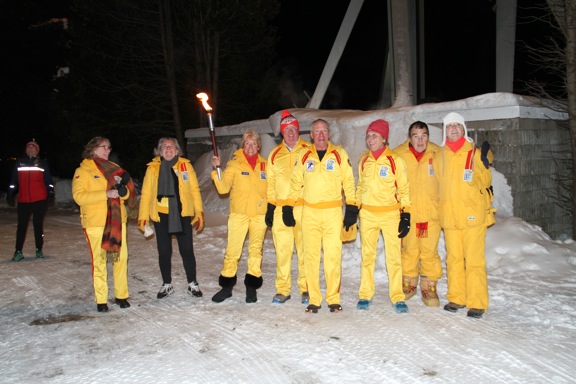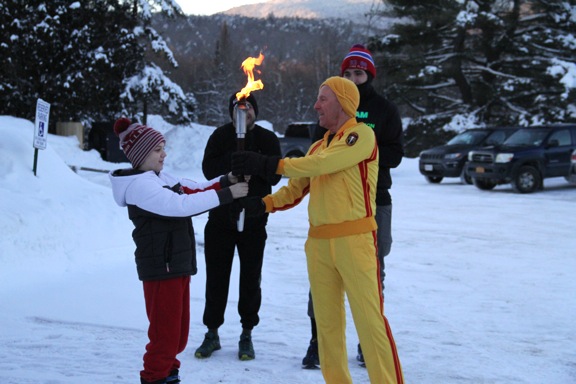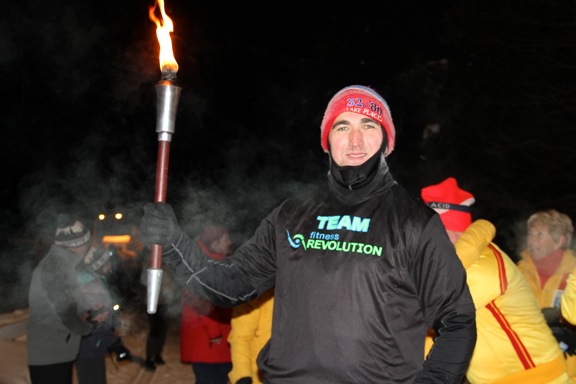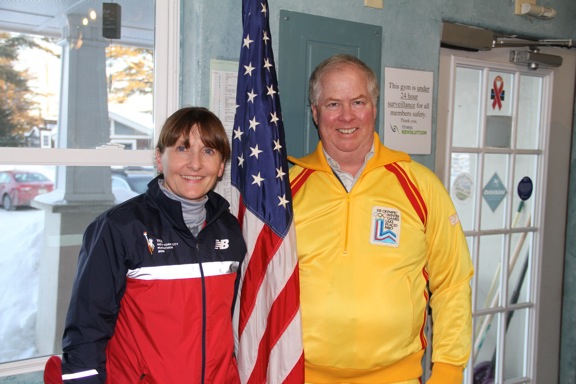The grateful 8
1980 Winter Olympic torch runners help light cauldron during 40th anniversary opening ceremony
- Eight of the 52 torch runners from the 1980 Olympic Winter Games pose at the North Elba Show Grounds Friday evening, Feb. 14, after the cauldron was lit for the opening ceremony of the 40th anniversary celebration of the games. There was one runner from each of the 50 states, plus Lake Placid and Washington, D.C. From left are Beverly Johnson (Maine), Carol Arnold (Delaware), Sandee Norris (Indiana), Sean McDevitt (Idaho), Steve Simon (Wyoming), Suzy Mink (Virginia), John Beaumont (Louisiana) and Alison Carlson (Wisconsin). (News photo — Andy Flynn)
- Griffin McComber hands Steve Simon the torch Friday, Feb. 14 to begin the torch run to the North Elba Show Grounds. (News photo — Andy Flynn)
- Ethan Gawel poses with the torch at Lake Placid’s 1980 Olympic cauldron Friday, Feb. 14. (News photo — Andy Flynn)
- Darci LaFave of Lake Placid and Sean McDevitt of Houston, Texas, pose inside the Fitness Revolution gym before the torch run to the North Elba Show Grounds Friday, Feb. 14. (News photo — Andy Flynn)

Eight of the 52 torch runners from the 1980 Olympic Winter Games pose at the North Elba Show Grounds Friday evening, Feb. 14, after the cauldron was lit for the opening ceremony of the 40th anniversary celebration of the games. There was one runner from each of the 50 states, plus Lake Placid and Washington, D.C. From left are Beverly Johnson (Maine), Carol Arnold (Delaware), Sandee Norris (Indiana), Sean McDevitt (Idaho), Steve Simon (Wyoming), Suzy Mink (Virginia), John Beaumont (Louisiana) and Alison Carlson (Wisconsin). (News photo — Andy Flynn)
LAKE PLACID — Sean McDevitt was a 16-year-old from Idaho on Jan. 31, 1980, when he began helping 51 other runners from around the United States bring the Olympic flame from Yorktown, Virginia, to Lake Placid for the XIII Olympic Winter Games.
“There were three of us that were really young: Idaho, Hawaii and Alaska. So myself, Matt Paulli (Alaska) and Stephen Paik (Hawaii). I think all three of us were around 16 when we started, and then we turned 17 here in the Olympics,” McDevitt said Friday, Feb. 14, at the Fitness Revolution gym in Lake Placid.
McDevitt and seven other 1980 torch bearers were getting ready for another torch run — 40 years later — from Saranac Avenue to Main Street, down to Sentinel Road and out to the North Elba Show Grounds for the opening ceremony of Lake Placid’s 40th anniversary Olympic celebration.
The other 1980 runners were Beverly Johnson (Maine), Carol Arnold (Delaware), Sandee Norris (Indiana), Steve Simon (Wyoming), Suzy Mink (Virginia), John Beaumont (Louisiana) and Alison Carlson (Wisconsin).
McDevitt has fond memories of this village’s second Winter Olympics, held from Feb. 13 to 24, 1980, the first Olympics being in 1932.

Griffin McComber hands Steve Simon the torch Friday, Feb. 14 to begin the torch run to the North Elba Show Grounds. (News photo — Andy Flynn)
“We stayed throughout the Olympics and provided ceremonial duties, such as goodwill ambassadors,” he said. “We assisted with the award ceremonies every night. We stayed for the entirety of the Olympics to include the closing ceremonies.”
On Feb. 25, a day after the closing ceremony at the 1980 Rink, McDevitt turned 17 years old.
“It was the pivotal moment of my life up to that point,” he said. “I was around really high-quality people that were doing amazing things, and it inspired me for the rest of my life.”
After high school graduation, McDevitt joined the U.S. Army, earning a bachelor’s degree in computer science from the U.S. Military Academy at West Point, class of 1985. As a member of the U.S. Army Rangers, he was decorated for combat in the invasion of Panama (Dec. 20, 1989). He earned an MBA from the Harvard Business School in the 1990s and went into business. He now lives in Houston, Texas.
—

Ethan Gawel poses with the torch at Lake Placid's 1980 Olympic cauldron Friday, Feb. 14. (News photo — Andy Flynn)
Torch run 1980
As reported in the Feb. 7, 1980, issue of the Lake Placid News, the Olympic flame was within 100 miles of the village and expected to arrive the next day.
There were 52 Olympic torch bearers — one from each of the 50 states, Washington, D.C. and Lake Placid — 26 men and 26 women. They met at the post office Friday, Feb. 8 before circling Mirror Lake. Lake Placid’s representative — veterinarian Dr. Robert Lopez — carried the flame into the 1980 Fieldhouse.
It was the end of a 1,000-mile torch relay from Virginia, but the flame’s journey was even longer.
The Olympic flame was lit on Wednesday, Jan. 30 in Olympia, Greece. From there, a Greek runner carried it by foot to Platanos, where it was transported by coach to the Andravida airport and by plane to Athens. The flame was presented to members of the Lake Placid Olympic Organizing Committee and transferred to a miner’s lamp, leaving the Athens Airport aboard an Air Force jet.

Darci LaFave of Lake Placid and Sean McDevitt of Houston, Texas, pose inside the Fitness Revolution gym before the torch run to the North Elba Show Grounds Friday, Feb. 14. (News photo — Andy Flynn)
It was then flown to Langley Air Force Base in Virginia, with a stopover in Shannon, Ireland, arriving on Jan. 31. Once on U.S. soil, it was transferred to a 65-foot naval vessel and transported 21 miles up the York River to Yorktown, Virginia, site of Gen. Cornwallis’ surrender to George Washington which ended the Revolutionary War and gave the U.S. its independence.
Lake Placid’s George Christian Ortloff, director of ceremonies and awards, received the miner’s lamp bearing the Olympic flame at dockside. Dr. Delbert Warner of Lake Placid then lit the first torch from it, and 27-year-old Suzy Mink, of Roanoke, Virginia, carried the torch the first 2 miles.
Even though the U.S. had hosted the Olympic Games four times prior — St. Louis in 1904, Lake Placid and Los Angeles in 1932, and Squaw Valley in 1960 — 1980 was the first time the Olympic flame had ever traveled to the U.S. from its origin in Olympia, Greece.
The U.S. torch run was designed to retrace the American Revolution Bicentennial Trail, starting in Yorktown, Virginia, where it was carried through notable cities such as Washington, D.C., Philadelphia and New York City.
Torch runners carried the flame to the State Capitol in Albany at 1 p.m. Feb. 6. It was there, during a brief ceremony, that they broke into two groups — one group carrying the flame up the East Adirondack Route and the other up the West Adirondack Route. The eastern runners stopped for the night at Saratoga Springs, and the western runners bedded down at Amsterdam.
On Feb. 7, the eastern runners followed a route bringing them through South Glens Falls, Glens Falls, Lake George, Diamond Point, Bolton Landing, Hague, Sabbath Point and Silver Bay and into Fort Ticonderoga, their last overnight stop before Lake Placid. The western runners traveled through Perth, Northville, Hope, Wells, Speculator, Sabael and into Indian Lake for their final overnight stay.
On Feb. 8, the two flames were reunited during a ceremony at the Olympic Speedskating Oval.
Charles Kerr, of Arizona, lit the cauldron with the Olympic flame during the opening ceremony at the North Elba Show Grounds on Feb. 13, 1980.
Constructed of bronze-colored leather and metal, the 1980 torch was 72.5 centimeters long. It was designed by Don McFarland and manufactured by Cleanweld Turner. The fuel was liquid propane, and the burning time was 40 minutes.
During medal ceremonies on Mirror Lake, “The Olympic flame was present in the form of torches held by bearers lining the path leading to the pavilion built on the frozen surface of the lake,” according to the International Olympic Committee.
For the closing ceremony, the Olympic flame was burning in a cauldron suspended from the ceiling of 1980 rink. Toward the end of the ceremony, this flame was extinguished at the same time as the main cauldron flame at the show grounds.
—
Torch run 2020
The torch run for the 40th anniversary celebration of the 1980 Winter Olympics began at Fitness Revolution at 5 p.m. Friday, Feb. 14 because the gym has a direct connection to the Olympic movement in Lake Placid, according to torch run organizer Molly Mayer, who works at the Regional Office of Sustainable Tourism. Teams from around the world work out at the gym while they’re in town training and competing — such as luge, bobsled and skeleton athletes at the Mount Van Hoevenberg sliding track.
“These are Olympic teams that are going on to compete in World Cups and to the Olympics,” Mayer said. “And so to have the past and the present kind of mold together makes this a really special spot for that, so it makes sense to start the torch relay from this location.”
Fitness Revolution owner Jason McComber, his wife Crystal and son Griffin were at the gym helping with the festivities.
“Being here for 20 years, it means a lot to us,” Jason said. “We’ve watched Olympic athletes go from junior teams to actually gold medals, silver medals. They trained right here in this building. We had 15 different teams this past year training.”
Two members of the Fitness Revolution “family” helped the 1980 torch runners with the relay to the North Elba Show Grounds: Bryce Stanton and local radio personality Ethan Gawel.
“I’ve been excited about it all week,” Gawel said before the run. “It’s probably one of the most exciting moments of my life so far.”
Gawel regularly works out at the gym and knows that he is sometimes among the world’s greatest winter athletes.
“These world-class athletes, when they’re in here, you don’t realize they’re world-class athletes,” Gawel said. “They’re not waving their flags when they’re in here. They’re not touting that, ‘OK, I’m on the Jamaican bobsled team’ or ‘I’m part of USA Luge.’ They’re in here to train for their craft and train for their sport and make sure they’re in the best possible physical shape that they can be in. And I think that’s the best memory. Everyone is in here working hard and having a good time doing it.”
After the torch was lit, Lake Placid sixth grader Griffin McComber handed it to Steve Simon, who was a torch runner from Wyoming in 1980, and with a police escort, the relay team made their way to the bus garage on Cascade Road, which was built for the 1980 Olympics and used as the broadcast center for ABC Sports. After a short break, at 6:09 p.m., they began running the torch to the opening ceremony at the North Elba Show Grounds, where Simon and Suzy Mink arrived with the torch together at the 1980 cauldron, which was then lit before the fireworks display — all in sub-zero temperatures.
“It was just exhilarating … to rekindle old feelings,” Simon said by phone Wednesday, Feb. 19. He now lives in Colorado. “It was a fantastic day all around. I didn’t even feel the cold.”






